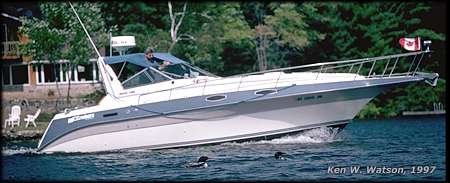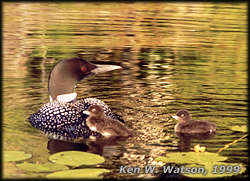


 |  |  |
| Explore the Rideau Canal and Friends of the Rideau by following these links: |
 Boaters and Loons
Common loons are large diving birds that spend their summers on open fresh water lakes and their winters on the seacoast. During the summer they sport distinctive black and white breeding plumage. They are 0.6 to 1 metre long, weigh 4 to 5 kilograms and have a wingspan of 1.2 to 1.5 metres.  There are many ways that watercraft can have a negative effect on loons:
On the Rideau, most loons start to nest from the middle to the end of May. They generally lay 2 eggs which will hatch 27 to 29 days later (late June). Nests are usually on small islands or the back end of bays and inlets. In several areas, local residents have constructed artificial loon nests (a floating platform, 1.2 to 1.8 metres square). Since loons only have one or two chicks per year, every chick counts. The survival of loons on the Rideau depends on these chicks staying healthy until they are strong enough to fly south (late October - November). Loon parents will leave the nest if a watercraft comes within 150 metres of the nest. This leaves the eggs without warmth or protection. Loon parents may abandon the nest if disturbed too often. If they try to re-nest later in the season, the likelihood of chicks hatching and surviving is very low.  Young chicks are not waterproof! They need to be able to climb on their parents’ backs to stay warm and dry. When watercraft come close, parents leave their chick to defend their territory. Young chicks are not waterproof! They need to be able to climb on their parents’ backs to stay warm and dry. When watercraft come close, parents leave their chick to defend their territory.Young chick can’t dive! Young chicks are very buoyant and can’t dive very quickly or very deep. This make them particularly vulnerable to being run over by watercraft, particularly from June to September. Chicks tire easily! The presence of watercraft causes chicks to keep swimming instead of feeding and resting. This can weaken them, affecting their ability to survive. Chicks frequent open water! It is the habit of loon parents to move the chicks away from the small bay nesting environment, out into deeper water along more open shorelines, to avoid their natural predators. Unfortunately this puts them into direct conflict with watercraft - particularly PWCs and boats pulling water-skiers. tubers and wake-boarders. Be aware of loons - be aware that if you see a loon from late June to September, chances are that one or two chicks will be close by. Keep your distance. Listen to loons - if you approach a loon and hear it start to call, this means you are too close. Move away. Watch what loons do - if you see a loon “dancing” straight up out of the water and slapping with its wings, it is alarmed by your presence. Move away.
View loons from a distance. Enjoy their lovely haunting calls. Give loons their space - they need solitude to breed and raise their young. Harassment of wildlife is against the law. If you see loons being harassed, report this to your local MNR office, local police or OPP, or call Crime Stoppers at 1-800-222-TIPS. Videotaping the event and/or recording the vessel’s registration number is helpful. Loons, like many birds, normally ingest small pebbles (grit) in order to help digest their food. Loons often have as many as 20-30 pebbles in their gizzard at one time. Unfortunately if this material contains lead, which can be in the form of small sinkers, jigs or shotgun shot, poisoning of the loon will occur. Non-toxic alternatives such as steel and bismuth are now readily available. So - get the lead out!
This brochure has been adapted from brochures produced by the Michigan Loon Preservation Association, www.michiganloons.org and the Montana Loon Society, www.montanaloons.org. Interested in building an artificial loon nesting platform? Detailed instructions for building such a nest using either cedar logs or PVC piping can be found at: (note that this link will take you off this website).
Comments about the website email: webmaster@rideaufriends.com |